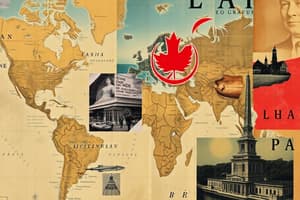Podcast
Questions and Answers
भौगोलिक तकनीकों में से कौन सी तकनीकें शामिल नहीं हैं?
भौगोलिक तकनीकों में से कौन सी तकनीकें शामिल नहीं हैं?
- दूर संवेदन
- जीआईएस (Geographic Information Systems)
- मौसम विज्ञान (correct)
- जीपीएस (Global Positioning System)
निम्नलिखित में से कौन सा भौगोलिक क्षेत्र की परिभाषा को सटीक रूप से समझाता है?
निम्नलिखित में से कौन सा भौगोलिक क्षेत्र की परिभाषा को सटीक रूप से समझाता है?
- अधिकांश आबादी द्वारा बसे हुए क्षेत्र
- व्यक्तिगत विशेषताओं से प्रभावित क्षेत्र
- एक विशेष तत्व के चारों ओर परिभाषित क्षेत्र
- जलवायु और संस्कृति द्वारा परिवर्तित क्षेत्र (correct)
भौगोलिक स्थलाकृति के किस घटक में आम तौर पर जल निकाय शामिल नहीं होते?
भौगोलिक स्थलाकृति के किस घटक में आम तौर पर जल निकाय शामिल नहीं होते?
- भूजल स्तर (correct)
- सपाट भूमि
- पहाड़
- घाटी
किस लम्बाई की माप को पृथ्वी के परिधि के संबंध में प्राथमिक मेरिडियन के पूर्व या पश्चिम में दूरी के रूप में जाना जाता है?
किस लम्बाई की माप को पृथ्वी के परिधि के संबंध में प्राथमिक मेरिडियन के पूर्व या पश्चिम में दूरी के रूप में जाना जाता है?
निम्नलिखित में से कौन सा तत्व मानव-पर्यावरण के बीच इंटरैक्शन को सबसे अच्छी तरह से दर्शाता है?
निम्नलिखित में से कौन सा तत्व मानव-पर्यावरण के बीच इंटरैक्शन को सबसे अच्छी तरह से दर्शाता है?
कौन सा जलवायु क्षेत्र तापमान की अत्यधिक विविधता को दर्शाता है?
कौन सा जलवायु क्षेत्र तापमान की अत्यधिक विविधता को दर्शाता है?
निम्नलिखित में से कौन सा सामाजिक-आर्थिक विषयभौगोलिक अध्ययन के लिए महत्वपूर्ण नहीं माना जाता?
निम्नलिखित में से कौन सा सामाजिक-आर्थिक विषयभौगोलिक अध्ययन के लिए महत्वपूर्ण नहीं माना जाता?
किस जानकारी प्रणाली का उपयोग करके भौगोलिक डेटा को संग्रहीत और विश्लेषित किया जाता है?
किस जानकारी प्रणाली का उपयोग करके भौगोलिक डेटा को संग्रहीत और विश्लेषित किया जाता है?
Flashcards are hidden until you start studying
Study Notes
Definition
- Geography is the study of the Earth's landscapes, environments, and the relationships between people and their environments.
Branches of Geography
-
Physical Geography
- Studies natural features of the Earth (landforms, climate, vegetation).
- Includes geology, meteorology, hydrology, and biogeography.
-
Human Geography
- Focuses on human activities and their spatial implications.
- Includes cultural geography, economic geography, urban geography, and political geography.
-
Geospatial Technologies
- Involves tools and techniques like GIS (Geographic Information Systems), GPS (Global Positioning System), and remote sensing.
Key Concepts
-
Location
- Absolute Location: Exact coordinates (latitude and longitude).
- Relative Location: Position in relation to other places.
-
Place
- Physical characteristics (landforms, climate) and human characteristics (culture, population).
-
Region
- Areas that are defined by certain unifying characteristics (e.g., climate zones, cultural regions).
-
Human-Environment Interaction
- Examines how people adapt to and modify their environment.
-
Movement
- Involves the flow of people, goods, and ideas across space.
Tools and Techniques
-
Maps
- Types include physical, political, thematic, and topographic maps.
- Essential for understanding spatial relationships.
-
GIS
- A system for capturing, storing, analyzing, and managing spatial data.
-
Remote Sensing
- Use of satellite or aerial imagery to collect data about the Earth's surface.
Major Geographic Features
-
Landforms
- Mountains, valleys, plains, plateaus, hills.
-
Water Bodies
- Oceans, rivers, lakes, seas.
-
Climate Zones
- Tropical, arid, temperate, polar.
Important Geographical Terms
- Latitude: Measures distance north or south of the equator.
- Longitude: Measures distance east or west of the Prime Meridian.
- Topography: Study of the arrangement of the natural and artificial physical features of an area.
- Biodiversity: Variety of life in a particular habitat or ecosystem.
Key Issues in Geography
- Urbanization: Growth of cities and their impact on the environment.
- Climate Change: Effects on weather patterns, sea levels, and biodiversity.
- Globalization: Increasing interconnection of economies and cultures.
- Sustainability: Balancing human needs with environmental conservation.
Career Paths in Geography
- Urban planner
- Environmental consultant
- Geographic information systems (GIS) specialist
- Cartographer
- Climatologist
भूगोल की परिभाषा
- भूगोल पृथ्वी के भूदृश्यों, पर्यावरणों और लोगों व उनके पर्यावरण के बीच संबंधों का अध्ययन है।
भूगोल की शाखाएँ
- भौतिक भूगोल: पृथ्वी की प्राकृतिक विशेषताओं (भू-आकृतियाँ, जलवायु, वनस्पति) का अध्ययन करता है; इसमें भूविज्ञान, मौसम विज्ञान, जल विज्ञान और जैव भूगोल शामिल हैं।
- मानव भूगोल: मानवीय गतिविधियों और उनके स्थानिक निहितार्थों पर केंद्रित है; इसमें सांस्कृतिक भूगोल, आर्थिक भूगोल, शहरी भूगोल और राजनीतिक भूगोल शामिल हैं।
- भू-स्थानिक तकनीकें: इसमें GIS (भौगोलिक सूचना प्रणाली), GPS (ग्लोबल पोजिशनिंग सिस्टम) और रिमोट सेंसिंग जैसे उपकरण और तकनीक शामिल हैं।
प्रमुख अवधारणाएँ
- स्थान: निरपेक्ष स्थान (अक्षांश और देशांतर) और सापेक्ष स्थान (अन्य स्थानों के संबंध में स्थिति)।
- स्थल: भौतिक विशेषताएँ (भू-आकृतियाँ, जलवायु) और मानवीय विशेषताएँ (संस्कृति, जनसंख्या)।
- क्षेत्र: कुछ एकीकृत विशेषताओं (जैसे, जलवायु क्षेत्र, सांस्कृतिक क्षेत्र) द्वारा परिभाषित क्षेत्र।
- मानव-पर्यावरण अंतःक्रिया: यह जांचता है कि लोग अपने पर्यावरण के अनुकूल कैसे होते हैं और उसे कैसे संशोधित करते हैं।
- गति: स्थान पर लोगों, वस्तुओं और विचारों के प्रवाह को शामिल करता है।
उपकरण और तकनीकें
- मानचित्र: भौतिक, राजनीतिक, विषयगत और स्थलाकृतिक मानचित्र शामिल हैं; स्थानिक संबंधों को समझने के लिए आवश्यक हैं।
- भौगोलिक सूचना प्रणाली (GIS): स्थानिक डेटा को कैप्चर करने, संग्रहीत करने, विश्लेषण करने और प्रबंधित करने की एक प्रणाली।
- रिमोट सेंसिंग: पृथ्वी की सतह के बारे में डेटा एकत्र करने के लिए उपग्रह या हवाई इमेजरी का उपयोग।
प्रमुख भौगोलिक विशेषताएँ
- भू-आकृतियाँ: पर्वत, घाटियाँ, मैदान, पठार, पहाड़ियाँ।
- जल निकाय: महासागर, नदियाँ, झीलें, समुद्र।
- जलवायु क्षेत्र: उष्णकटिबंधीय, शुष्क, समशीतोष्ण, ध्रुवीय।
महत्वपूर्ण भौगोलिक शब्द
- अक्षांश: भूमध्य रेखा के उत्तर या दक्षिण में दूरी मापता है।
- देशांतर: प्रधान मध्याह्न रेखा के पूर्व या पश्चिम में दूरी मापता है।
- स्थलाकृति: किसी क्षेत्र की प्राकृतिक और कृत्रिम भौतिक विशेषताओं की व्यवस्था का अध्ययन।
- जैव विविधता: किसी विशेष आवास या पारिस्थितिकी तंत्र में जीवन की विविधता।
भूगोल में प्रमुख मुद्दे
- शहरीकरण: शहरों का विकास और पर्यावरण पर उनका प्रभाव।
- जलवायु परिवर्तन: मौसम के पैटर्न, समुद्र के स्तर और जैव विविधता पर प्रभाव।
- वैश्वीकरण: अर्थव्यवस्थाओं और संस्कृतियों का बढ़ता हुआ अंतर्संबंध।
- सततता: मानवीय आवश्यकताओं को पर्यावरण संरक्षण के साथ संतुलित करना।
भूगोल में कैरियर पथ
- शहरी योजनाकार
- पर्यावरणीय सलाहकार
- भौगोलिक सूचना प्रणाली (GIS) विशेषज्ञ
- मानचित्रकार
- जलवायु विज्ञानी
Studying That Suits You
Use AI to generate personalized quizzes and flashcards to suit your learning preferences.




